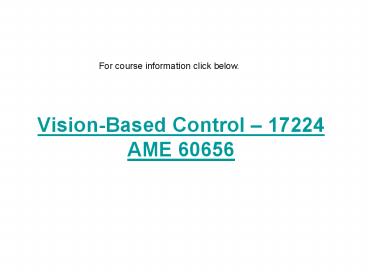VisionBased Control 17224 AME 60656 - PowerPoint PPT Presentation
1 / 30
Title:
VisionBased Control 17224 AME 60656
Description:
'We don't actually make robots; what we make are just programmable machines' ... Startling words from a chief researcher at one of the largest 'robot ... – PowerPoint PPT presentation
Number of Views:53
Avg rating:3.0/5.0
Title: VisionBased Control 17224 AME 60656
1
Vision-Based Control 17224AME 60656
For course information click below.
2
We dont actually make robots what we make are
just programmable machines.
3
We dont actually make robots what we make are
just programmable machines.
- Startling words from a chief researcher at one of
the largest robot manufacturers in the world.
4
We dont actually make robots what we make are
just programmable machines.
- What does he mean?
5
We dont actually make robots what we make are
just programmable machines.
- What does he mean?
- Are these not robots?
6
- And what makes this a robot?
7
- Are these robots?
8
- How about this?
9
We dont actually make robots what we make are
just programmable machines.
- Our research manager is not alone consider this
from the U.S. federal government
10
Committee on the Assessment of Options for
Extending the Life of the Hubble Space Telescope,
National Research Council, Appendix D, State of
the Art in Robotics -- 2005
11
It is difficult to control a robotic arm
with anything remotely approaching the
capabilities of a human being.
12
Many robots are teleoperated. In teleoperation,
a human operator controls the robot directly.
13
(Why is this a robot, but not this?)
14
The meaning of robot has evolved
inconsistently. But in any case, our manager was
not thinking of the human in the loop forms.
15
In spirit, industrial robots are closer to
machines like programmablelooms or dishwashers
than to Hollywoods R2D2.
16
Most industrial robots simply repeat previously
taught joint motion.
17
Managers point is that teach/repeat systems
dont have the sensor-based responsiveness most
people assume.
18
But all that may change, radically, within a
decade.
19
But all that may change, radically, within a
decade.
- If this kind of machine has been around for fifty
years, why would the research manager say this?
20
But all that may change, radically, within a
decade.
- What would change?
- Would the machines be different?
21
But all that may change, radically, within a
decade.
- And what would make the prospect of such a change
so exciting for a manufacturer of these machines?
22
But all that may change, radically, within a
decade.
- It has more to do with the way these machines are
used. The hardware need not change.
23
Consider the motion of this industrial robot.
24
Every part of this impressive motion is taught
every part except the loose-bag engagement.
25
With the exception of the bag-engage movement,
which is visually guided, the action of this
machine is successful only if everything in the
environment remains in place.
26
With the exception of the bag-engage movement,
which is visually guided, the action of this
machine is successful only if everything in the
environment remains in place.
27
With the exception of the bag-engage movement,
which is visually guided, the action of this
machine is successful only if everything in the
environment remains in place.
28
With the exception of the bag-engage movement,
which is visually guided, the action of this
machine is successful only if everything in the
environment remains in place.
29
But the six-degree-of-freedom mechanism is
mechanically capable of responding to
as-located elements anywhere within its
workspace.
30
Therefore, if the system had the wherewithal to
respond to as-located, the number of these same
mechanisms that could be sold could grow by
orders of magnitude.































